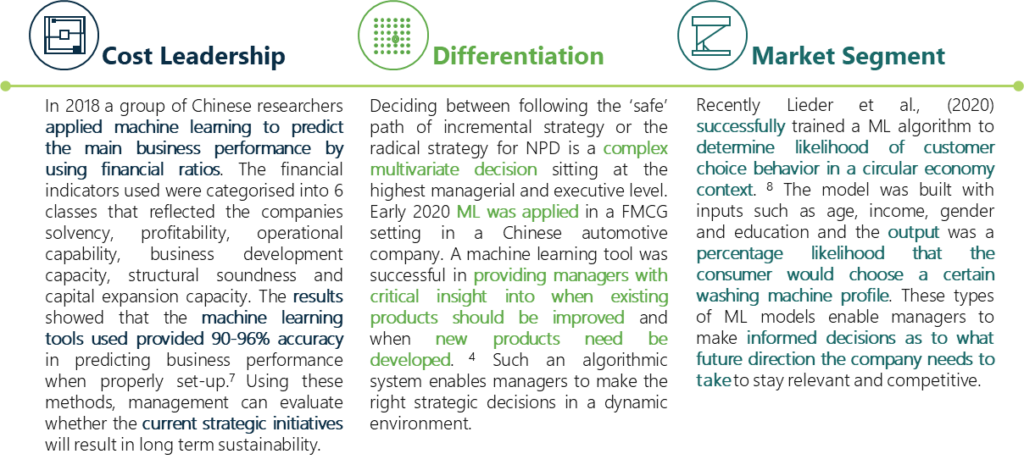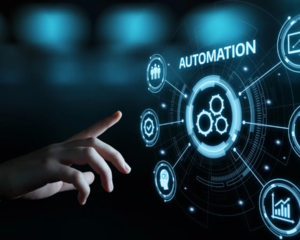Author: Vincent Le Roux
Over the last four years, the term ‘machine learning’ (ML) has seen a steady climb in popularity, with a 67% increase in search frequency on Google. This has been coupled by a 25% year-on-year increase in the use of Artificial Intelligence (AI) in standard business cases, according to a recent global survey.
The survey also found that the highest adoption of ML occurred in the high tech and telecommunications industries, with 54% and 45% of respondents adopting the technology in 2019 respectively. While AI use cases vary from industry to industry, they are focused on the activities most relevant to industry-specific value chains. Forecasts suggest that businesses will spend a total of US $98 billion in 2023 on AI systems worldwide, compared to $38 billion in 2019.
Despite AI’s increasing adoption and known advantages, with automation a notable example, there are still firms reluctant to explore the art of the possible. A report by MIT Sloan Management Review highlighted that although 85% of interviewees believe AI will give their business distinctiveness and a competitive edge, a mere 39% had a comprehensive AI strategy in place.
The report discussed three key aspects that led to a reluctance in AI adoption:
- Non-existent or rudimentary AI strategy,
- The lack of a basic understanding of AI capabilities, and
- Limited access to AI resources and talents within the organisation
Outside of the financial sector, this reluctance towards adoption is especially true in South Africa. Most businesses are either at the start of their digital journey, where they have implemented or plan to implement a strategy to digitise and/or digitilise business processes, or they are just beginning to reap the benefits of their upfront digital investments.
An important reason for South Africa’s slow pace of AI and ML adoption is linked to that lack of basic understanding. According to Letsema’s 2019 survey of 26 leading South African supply chain and procurement company executives, among a range of digital tools, AI and ML were the least understood technologies.
More so, a year-on-year comparison to the 2018 survey showed that this level of understanding has only worsened. This is despite AI and ML’s growing influence, yet how these key technologies can practically be applied to unlock business efficiencies remains a stumbling block.
How AI and ML application enables strategy
The power of AI and ML technology lies in the ability to analyse troves of structured or unstructured, multi-variate datasets and draw valuable insights from these collations of disparate data sources. Additional insights can be further sourced from these models by altering the existing business datasets with metadata from external data sources, which can include macroeconomic data, weather, commodity fluctuations etc.
It is this specific quality of ML and AI models that make them the perfect tool for assisting in strategic business decisions to actively drive business growth. By utilising these models to forecast future unit sales, test various market strategies, model cannibalising effects, and project future business growth, top management can make informed decisions on new product strategies, specific marketing campaigns and effectively run a more lean operation.
As per Porter’s Generic Strategies, at a high level, business strategy can typically be divided into three distinct categories: cost leadership, differentiation, and market segmentation. Cost leadership centres on the strategic pricing of a product by utilising economies of scale to drive down production cost whilst maximising production volume. Differentiation focuses on the central idea of a business having a unique offering – either a product or a service – which provides superior value to the market. Market segmentation revolves around choosing and focusing on a specific industry segment.
Figure 1 shows examples of how ML and AI tools have been recently applied to assist in strategic business decisions, grouped within Porter’s three distinct categories.

We can see that AI and ML tools are successful in supplementing executives’ decisions in companies’ differentiation, cost and market segmentation strategies. These use cases also show that AI and ML tools can be used as an evaluator of current business strategy to establish if it will yield healthy profit margins and set the company on a growth trajectory.
The journey to ML and AI adoption
In South Africa, as noted above, executive’s disinclination to invest in AI and ML solutions can be attributed to two fundamental problems.
The first is their lack of understanding of AI and ML technology, its application, and the realised benefit to industry-specific problems. This lack of understanding leads to a understanding deficit in what is required to build and deploy a ML or AI solution, a lack of analytics expertise, and inhibited access to company data.
Once the understanding barrier is overcome, the next problem executives face is identifying the path of least resistance to efficiently and effectively utilise AI and ML tools to solve their specific business problems.
The journey to AI and ML implementation does not start with advanced algorithms to streamline, automate, and revolutionise current ways of working. The path to AI nirvana is instead a sequential process where a foundation is laid which then supports the entire solution. This sequential process, depicted in Figure 2, is as follows:
- Collection phase: The focus is identifying the various data sources and their locations. Understanding, cleansing, formatting and augmenting existing datasets is a critical part of the collection phase
- Visualisation phase: Centred on real-time visibility of key business processes and related external macroeconomic and microeconomic attributes
- Insights phase: Visualisations and correlations are analysed and explored, hypotheses are tested, advanced analytics are applied and various scenarios are modelled to ultimately inform critical business decisions

Letsema’s AI and ML Competence
At Letsema’s Next-Gen Operation (NGO) practice, our portfolio of seasoned consultants with extensive expertise in Big Data, advanced analytics, corporate and digital strategy development, technology assessment, and implementation are ready to address any digital, machine learning, and AI-related business challenge.
Letsema utilises the end-to-end business intelligence value chain, enabling companies to draw valuable insights from raw, unstructured data sources using advanced analytics and leading AI and ML tools. Our offering is detailed in Figure 3:

Case study: ML applied in the FMCG sector
Recently, Letsema’s NGO team built a ML-driven dashboard, marrying the world of business intelligence with that of AI. The model uses existing business intelligence applications and model visualisation media, allowing users to easily change model feature inputs, and to understand, interpret, and interact with the ML module.
Our approach simplified the complex world of ML, and packages input data and insight output in an easily understandable and familiar environment.
Problem
Our client produces a range of bottled water products, including flavoured, unflavoured, still, and sparkling. In total, more than 65 stock keeping units (SKUs) are produced and sold in South Africa and across Southern Africa.
Currently, forecasting is done via monitoring average-daily-use (ADU), with the production plan adjusted accordingly. The client required a highly accurate, flexible, and robust machine learning forecasting solution that easily integrated with their existing business IT infrastructure and provided them with enhanced business foresight.
Approach and Solution
Letsema’s Data and Analytics Team analysed available data files and conducted thorough stakeholder engagements to understand the business’s problems and rules to establish what suitable features could be used to augment the existing dataset.
The provided data set was augmented with living standard measure (LSM) features, macroeconomic features and seasonal consumer effects, such as holidays. The ML modules were then built, optimised, and deployed in Power BI Desktop. This front-end tool was chosen to enable interactive scenario modelling, flexible forecast updates and to minimise implementation time and project cost.

Conclusion
As shown by the case study examples provided above, two commonalities were visible regarding the use of AI and ML:
- Identification of a business problem that required an out of the box non-traditional solution
- Historical data needed to solve the problem was available either internally or externally
Finding the solution, characteristics of ML and AI projects, means building and deploying a custom model that suits business requirements. Here, Letsema has and can help other organisations unable to pursue the detailed use of ML and AI in their businesses, but who understand the value these technologies hold for improving business processes and creating efficiencies.
If your digital strategy wishes to utilise ML as a Service (MLaaS), educate relevant stakeholders on the business-specific applications of ML and AI, or leverage these technologies to enhance business performance, contact Kamendran Govender, Partner of Letsema’s Next-Gen Operations practice, at nextgen.operations@letsema.co.za, connect with him on LinkedIn or call 011 233 0000.









